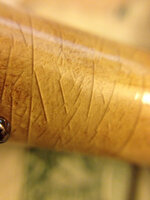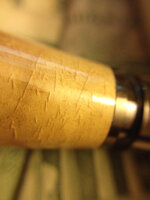Step back and re-evaluate!!
You don't have to AGREE with my thoughts, but at least decide WHY you don't agree.
For many years, wood has been considered "rich" and "warm". It has been coated with numerous oils, that enrich it by "soaking in" or "building" to a shine. But there has remained the "feel" of smooth, luxurious wood.
Now, we are attempting to put a plastic coat on the wood. We claim it will make the pen more "durable". But, will it? FACT is, we don't know. There is substantial evidence that the coating will crack, or there will be "whiting". So, why are we so convinced this is a GOOD way to treat our pens??
I liked CA, originally. But I LOVE knowing my customer will be happy and, at present, there is no way to KNOW CA will last. Spray lacquer is a certainty---more difficult to apply, but a KNOWN durability. Woodturners Finish is another "good bet" based on it's history as a floor finish.
Personally, I recommend abandoning the CA build up. Buy plastic blanks and make plastic pens---the material will "move" at one speed, so it will not encourage cracking AND there is no moisture to suddenly show itself UNDER your finish.
Your customer will LOVE their pen and come back to you to praise your craftsmanship. NOT complain about your cracking plastic finish, applied to their NATURALLY BEAUTIFUL Exotic wood.
Call me "old-fashioned", but I think "hand-made pens" are a tribute to the past, particularly in this age of "typed communication".
FWIW,
Ed


